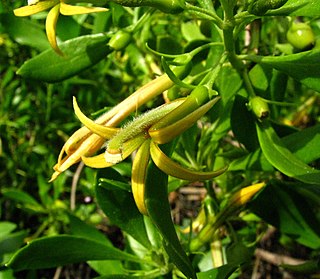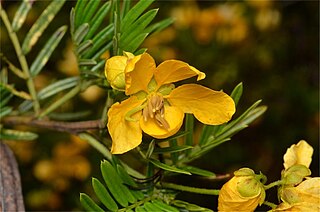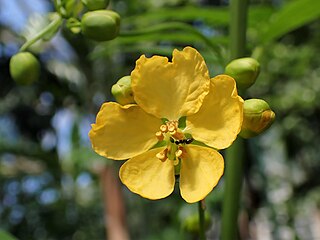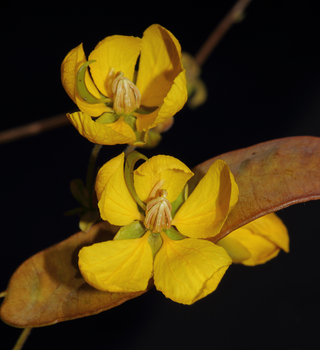
Senna multiglandulosa, commonly known as glandular senna, downy senna, or buttercup bush is a species of flowering plant in the family Fabaceae and is native to Mexico, Guatemala, and western parts of South America. It is a shrub with pinnate leaves, usually with six to eight pairs of linear to lance-shaped leaflets, and yellow flowers arranged in groups of ten to twenty, with seven fertile stamens in each flower. It is widely cultivated as an ornamental plant and in some areas of the world has become naturalized.

Senna septemtrionalis, commonly known as arsenic bush, is a species of flowering plant in the family Fabaceae and is native to Central America, the southern United States and Mexico, but is naturalised in many other countries. It is an erect shrub with pinnate leaves, with four or five pairs of egg-shaped leaflets, and yellow flowers arranged in groups of five to eight, usually with seven fertile stamens and four staminodes in each flower.

Senna acclinis, commonly known as rainforest cassia or brush senna, is a species of flowering plant in the family Fabaceae and is endemic to near-coastal areas of eastern Australia. It is a shrub with pinnate leaves and bright golden yellow flowers in groups of two to five and long, narrow seed pods. It is similar to other species of Senna that are environmental weeds.

Scaevola gaudichaudii, the ridgetop naupaka, is a shrub in the family Goodeniaceae. The flowers are yellow. The plant is endemic to Hawaii.

Senna aciphylla, commonly known as sprawling senna or Australian senna, is a species of flowering plant in the family Fabaceae and is endemic to eastern Australia. It is a sprawling shrub with pinnate leaves with eight to twelve pairs of linear to narrowly elliptic leaflets, and yellow flowers in pairs or groups of three.

Senna barclayana, commonly known as smooth senna or pepper-leaf senna, is a species of flowering plant in the family Fabaceae and is endemic to eastern Australia. It is a herbaceous perennial or subshrub with pinnate leaves with six to ten pairs of lance-shaped or narrowly elliptic leaflets, and yellow flowers in groups of six to ten.

Senna barronfieldii, commonly known as southern cassia, is a species of flowering plant in the family Fabaceae and is endemic to eastern Australia. It is an erect shrub with more or less glabrous, pinnate leaves with eight to thirteen pairs of lance-shaped or elliptic leaflets, and yellow flowers in groups of three to five.

Senna cardiosperma is a species of flowering plant in the family Fabaceae and is endemic to the western half of Australia. It is an erect shrub or small tree with pinnate leaves, the number and shape of the leaflets depending on subspecies, yellow flowers with ten fertile stamens in each flower, and flat pods.

Senna circinnata, commonly known as coiled cassia, is a species of flowering plant in the family Fabaceae and is endemic to eastern Australia. It is a shrub or small tree with pinnate leaves with one to three pairs of egg-shaped leaflets, and small groups of yellow flowers in upper leaf axils.

Senna coronilloides, commonly known as brigalow senna, is a species of flowering plant in the family Fabaceae and is endemic to eastern Australia. It is an erect, sprawling shrub with pinnate leaves with nine to twelve pairs of elliptic leaflets, and groups of three to five yellow flowers in upper leaf axils.

Senna costata is a species of flowering plant in the family Fabaceae and is endemic to northern Australia. It is a shrub or small tree with pinnate leaves with four or five pairs of narrowly elliptic leaflets, and yellow flowers arranged in pairs or groups of five to eight, with ten fertile stamens in each flower.
Senna curvistyla is a species of flowering plant in the family Fabaceae and is endemic to north-western Australia. It is an undershrub with pinnate leaves with two or three pairs of narrowly elliptic to elliptic leaflets, the flowers yellow and arranged in groups of two or three, with ten fertile stamens in each flower.
Senna goniodes is a species of flowering plant in the family Fabaceae and is endemic to the far north of Western Australia. It is an erect, slender shrub with pinnate leaves with two or three pairs of narrowly elliptic to elliptic leaflets, and yellow flowers arranged in groups with ten fertile stamens in each flower.
Senna heptanthera is a species of flowering plant in the family Fabaceae and is endemic to Arnhem Land in the north of the Northern Territory. It is a creeping, herbaceous perennial with pinnate leaves with one or two pairs of broadly egg-shaped leaflets, and yellow flowers arranged in groups of eight to ten, with seven fertile stamens in each flower.

Senna hirsuta, commonly known as woolly senna, is a species of flowering plant in the family Fabaceae and is native to Central and South America, but is naturalised in many other countries. It is an erect or spreading shrub or herbaceous perennial with pinnate leaves, with two to six pairs of egg-shaped leaflets, and yellow flowers arranged in groups of two to six, with six fertile stamens and four staminodes in each flower.

Senna magnifolia is a species of flowering plant in the family Fabaceae and is endemic to northern Australia. It is an erect, spreading or straggling, mostly glabrous shrub with pinnate leaves with four to six pairs of broadly oblong to round leaflets, and yellow flowers arranged in groups of twenty to sixty, with seven fertile stamens in each flower.
Senna manicula is a species of flowering plant in the family Fabaceae and is endemic to inland Western Australia. It is an erect shrub with pinnate leaves with three or four pairs of linear leaflets, and yellow flowers arranged singly or in pairs, with ten fertile stamens in each flower.

Senna oligoclada is a species of flowering plant in the family Fabaceae and is endemic to northern Australia. It is an erect shrub with pinnate leaves with one to three pairs of elliptic to egg-shaped leaflets, and yellow flowers arranged in groups of three to five with ten fertile stamens in each flower.

Senna pilocarina is a species of flowering plant in the family Fabaceae and is endemic to inland Western Australia. It is a prostrate or upright, spreading shrub with pinnate leaves with five to nine pairs of oblong to wedge-shaped leaflets, and yellow flowers arranged in groups of four or five, with ten fertile stamens in each flower.
Senna sericea is a species of flowering plant in the family Fabaceae and is endemic to inland north-western Australia. It is an erect shrub with pinnate leaves, with one or two pairs of egg-shaped leaflets, and yellow flowers arranged in groups of four to twelve, with ten fertile stamens in each flower.
















